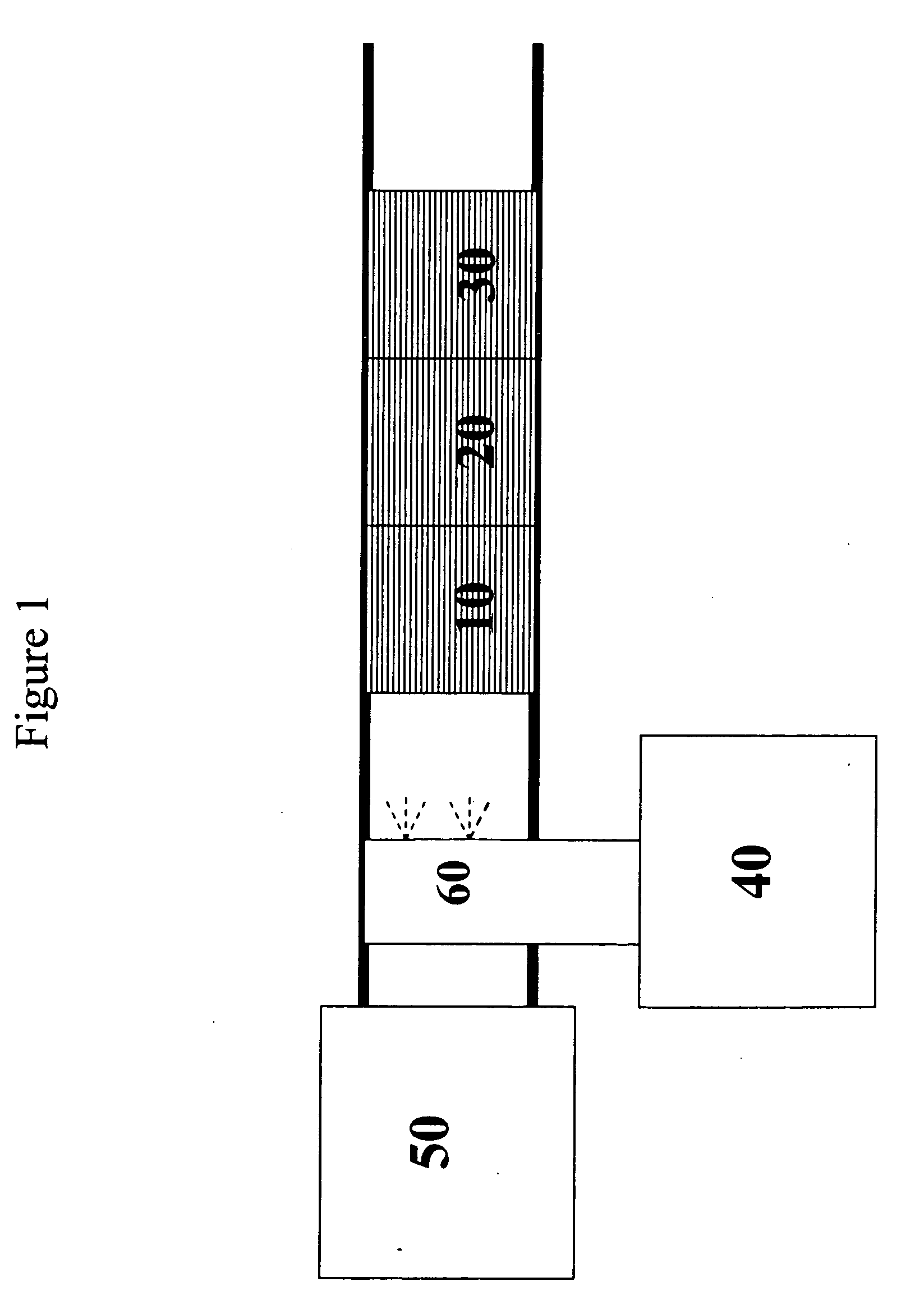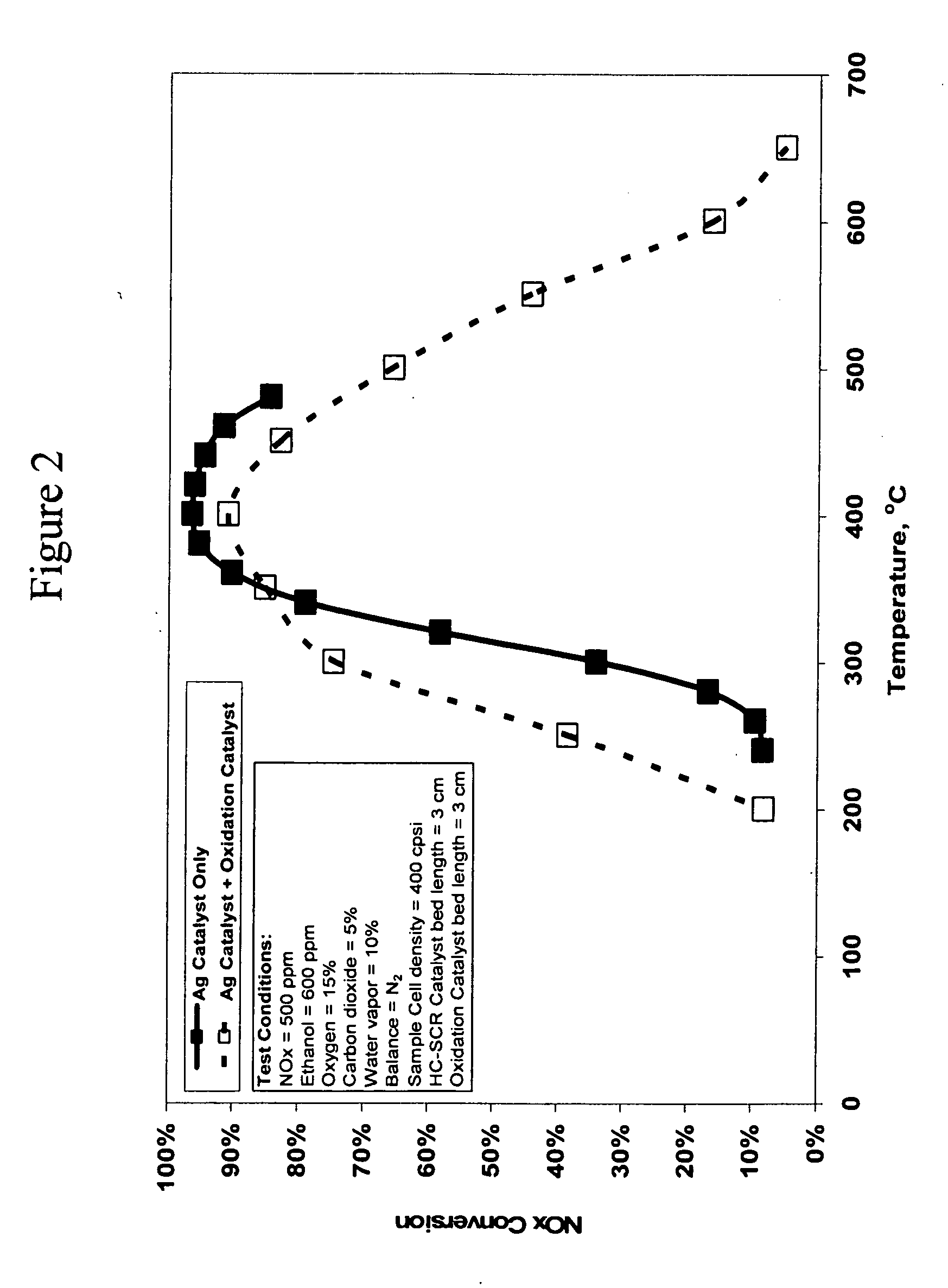Catalyst and method for reducing nitrogen oxides in exhaust streams with hydrocarbons or alcohols
a technology of hydrocarbons and nitrogen oxides, which is applied in the direction of physical/chemical process catalysts, arsenic compounds, separation processes, etc., can solve the problems of difficult selective reduction of nosub>x /sub>in this oxidizing environment, the effect of three-way catalysts is not good, and the emission limits of nitrogen oxides and carbon monoxide and hydrocarbons are subject to limits
- Summary
- Abstract
- Description
- Claims
- Application Information
AI Technical Summary
Benefits of technology
Problems solved by technology
Method used
Image
Examples
example 1
NOx Conversion Over a Silver on Alumina Catalyst With and Without an Oxidation Catalyst as a Function of Temperature
[0175] A silver / alumina monolith catalyst was prepared as follows. By mixing water, silver nitrate, and alumina, a slurry was formed. This slurry was ball milled and coated on a 400 cells per square inch monolith substrate and calcined at 600° C. to produce a 1.2% silver on alumina monolith substrate coated catalyst 10.
[0176]FIG. 2 shows a graph of the NOx conversion versus temperature in degrees Centigrade for the 1.2% Ag / Al2O3 catalyst 10 with and without a platinum on alumina oxidation catalyst 30 placed in the feed stream after the silver catalyst, as shown in FIG. 1. The test was conducted with a feedstream that contained 500 ppm NOx and 600 ppm ethanol. The feed gas also contained 15% oxygen, 5% carbon dioxide, 10% water vapor, with the balance being nitrogen. The flow rate of the feed stream was maintained at one standard liter per minute, which corresponds to...
example 2
NOx Conversion Over Silver Catalysts With and Without an Oxidation Catalyst With a Feedstream Containing 25 ppm NOx
[0178] Silver / alumina monolith catalysts were prepared with two different preparation methods. Catalyst 1 was prepared with a one step washcoat method as described in Example 1.
[0179] Catalyst 2 was prepared with a two step process by washcoating the substrate with alumina and then impregnating the alumina washcoat with an aqueous solution of silver nitrate. Catalyst 2 was prepared as follows. An alumina slurry was formed by mixing alumina and water. The slurry was ball milled, coated on a 400 cells per square inch monolith substrate, and dried. Silver nitrate was impregnated on the alumina coated monolith and calcined at 600° C. to produce a 1.2% silver on alumina catalyst.
[0180] The metal loadings on the calcined monolith catalysts are shown in Table 2, where the percent loadings are calculated on a metal basis relative to the weight of the alumina support.
TABLE ...
example 3
NOx Conversion and CO Production over a Silver / Alumina Catalyst With a Feedstream Containing 9 ppm NOx With Propane as a Reductant with and Without an Oxidation Catalyst
[0186]FIG. 4 shows a series of graphs of NOx conversion (left hand axis) and outlet CO (right hand scale) versus temperature for a silver / alumina catalyst with 6000 ppm propane as a reductant with a feedgas that contained 9 ppm NOx. The feed gas also contained 12% oxygen, 4% carbon dioxide, and 10% water vapor, with the balance being nitrogen. The test was conducted at a space velocity of 8000 hr−1.
[0187] CO was produced as a byproduct of NOx conversion when propane was used as a reductant. Oxidizing the CO with an oxidation catalyst removed the CO. However, the apparent NOx conversion declined significantly in the presence of an oxidation catalyst, as shown in FIG. 4. It is believed that the oxidation catalyst may have oxidized the nitrogen-containing intermediates formed via reaction 1, thereby lowering the appar...
PUM
| Property | Measurement | Unit |
|---|---|---|
| Temperature | aaaaa | aaaaa |
| Temperature | aaaaa | aaaaa |
| Temperature | aaaaa | aaaaa |
Abstract
Description
Claims
Application Information
 Login to View More
Login to View More - R&D
- Intellectual Property
- Life Sciences
- Materials
- Tech Scout
- Unparalleled Data Quality
- Higher Quality Content
- 60% Fewer Hallucinations
Browse by: Latest US Patents, China's latest patents, Technical Efficacy Thesaurus, Application Domain, Technology Topic, Popular Technical Reports.
© 2025 PatSnap. All rights reserved.Legal|Privacy policy|Modern Slavery Act Transparency Statement|Sitemap|About US| Contact US: help@patsnap.com



